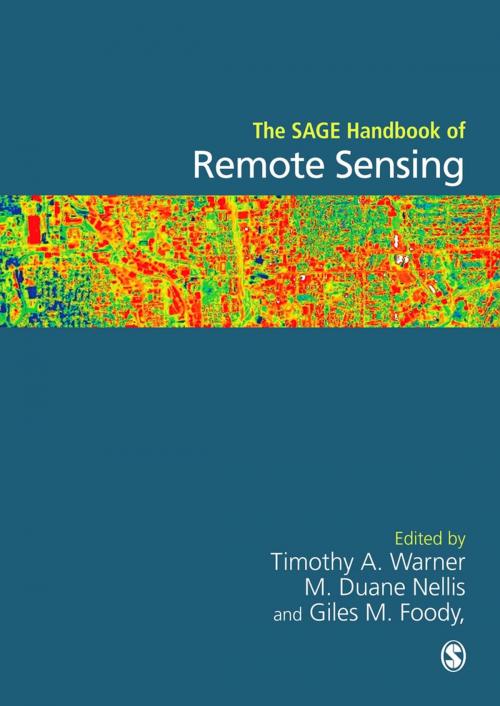The SAGE Handbook of Remote Sensing
Nonfiction, Science & Nature, Science, Biological Sciences, Environmental Science| Author: | ISBN: | 9781446246146 | |
| Publisher: | SAGE Publications | Publication: | June 18, 2009 |
| Imprint: | SAGE Publications Ltd | Language: | English |
| Author: | |
| ISBN: | 9781446246146 |
| Publisher: | SAGE Publications |
| Publication: | June 18, 2009 |
| Imprint: | SAGE Publications Ltd |
| Language: | English |
'A magnificent achievement. A who's who of contemporary remote sensing have produced an engaging, wide-ranging and scholarly review of the field in just one volume' - Professor Paul Curran, Vice-Chancellor, Bournemouth University
Remote Sensing acquires and interprets small or large-scale data about the Earth from a distance. Using a wide range of spatial, spectral, temporal, and radiometric scales Remote Sensing is a large and diverse field for which this Handbook will be the key research reference.
Organized in four key sections:
• Interactions of Electromagnetic Radiation with the Terrestrial Environment: chapters on Visible, Near-IR and Shortwave IR; Middle IR (3-5 micrometers); Thermal IR ; Microwave
• Digital sensors and Image Characteristics: chapters on Sensor Technology; Coarse Spatial Resolution Optical Sensors ; Medium Spatial Resolution Optical Sensors; Fine Spatial Resolution Optical Sensors; Video Imaging and Multispectral Digital Photography; Hyperspectral Sensors; Radar and Passive Microwave Sensors; Lidar
• Remote Sensing Analysis - Design and Implementation: chapters on Image Pre-Processing; Ground Data Collection; Integration with GIS; Quantitative Models in Remote Sensing; Validation and accuracy assessment;
• Remote Sensing Analysis - Applications: LITHOSPHERIC SCIENCES: chapters on Topography; Geology; Soils; PLANT SCIENCES: Vegetation; Agriculture; HYDROSPHERIC and CRYSOPHERIC SCIENCES: Hydrosphere: Fresh and Ocean Water; Cryosphere; GLOBAL CHANGE AND HUMAN ENVIRONMENTS: Earth Systems; Human Environments & Links to the Social Sciences; Real Time Monitoring Systems and Disaster Management; Land Cover Change
Illustrated throughout, an essential resource for the analysis of remotely sensed data, the SAGE Handbook of Remote Sensing provides researchers with a definitive statement of the core concepts and methodologies in the discipline.
'A magnificent achievement. A who's who of contemporary remote sensing have produced an engaging, wide-ranging and scholarly review of the field in just one volume' - Professor Paul Curran, Vice-Chancellor, Bournemouth University
Remote Sensing acquires and interprets small or large-scale data about the Earth from a distance. Using a wide range of spatial, spectral, temporal, and radiometric scales Remote Sensing is a large and diverse field for which this Handbook will be the key research reference.
Organized in four key sections:
• Interactions of Electromagnetic Radiation with the Terrestrial Environment: chapters on Visible, Near-IR and Shortwave IR; Middle IR (3-5 micrometers); Thermal IR ; Microwave
• Digital sensors and Image Characteristics: chapters on Sensor Technology; Coarse Spatial Resolution Optical Sensors ; Medium Spatial Resolution Optical Sensors; Fine Spatial Resolution Optical Sensors; Video Imaging and Multispectral Digital Photography; Hyperspectral Sensors; Radar and Passive Microwave Sensors; Lidar
• Remote Sensing Analysis - Design and Implementation: chapters on Image Pre-Processing; Ground Data Collection; Integration with GIS; Quantitative Models in Remote Sensing; Validation and accuracy assessment;
• Remote Sensing Analysis - Applications: LITHOSPHERIC SCIENCES: chapters on Topography; Geology; Soils; PLANT SCIENCES: Vegetation; Agriculture; HYDROSPHERIC and CRYSOPHERIC SCIENCES: Hydrosphere: Fresh and Ocean Water; Cryosphere; GLOBAL CHANGE AND HUMAN ENVIRONMENTS: Earth Systems; Human Environments & Links to the Social Sciences; Real Time Monitoring Systems and Disaster Management; Land Cover Change
Illustrated throughout, an essential resource for the analysis of remotely sensed data, the SAGE Handbook of Remote Sensing provides researchers with a definitive statement of the core concepts and methodologies in the discipline.















